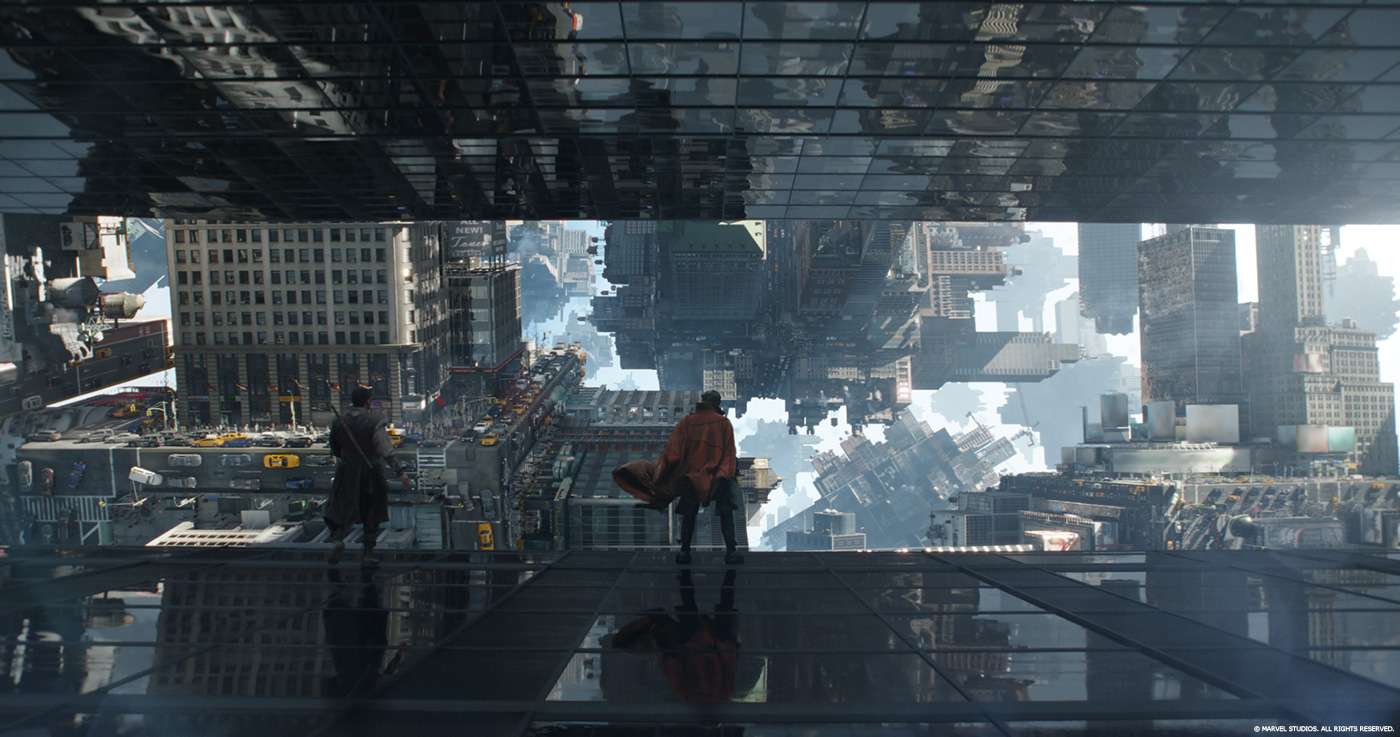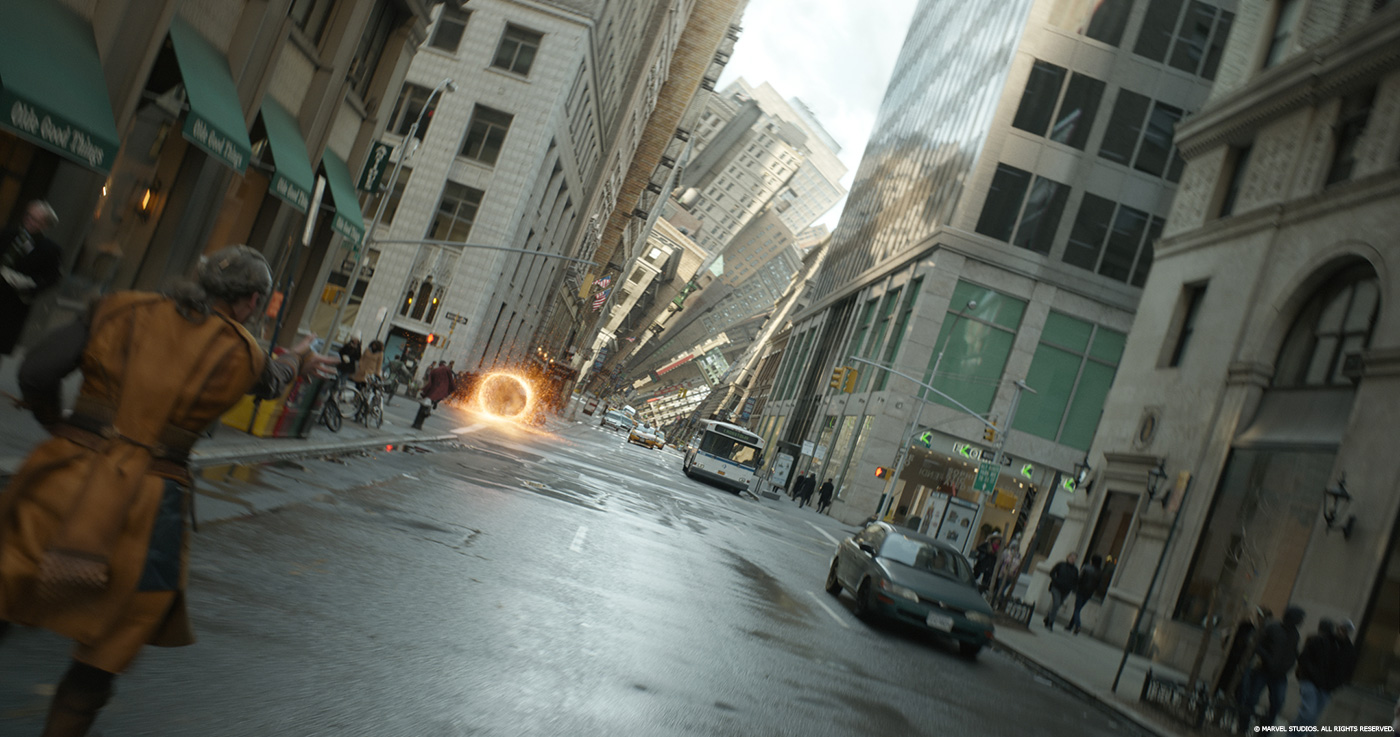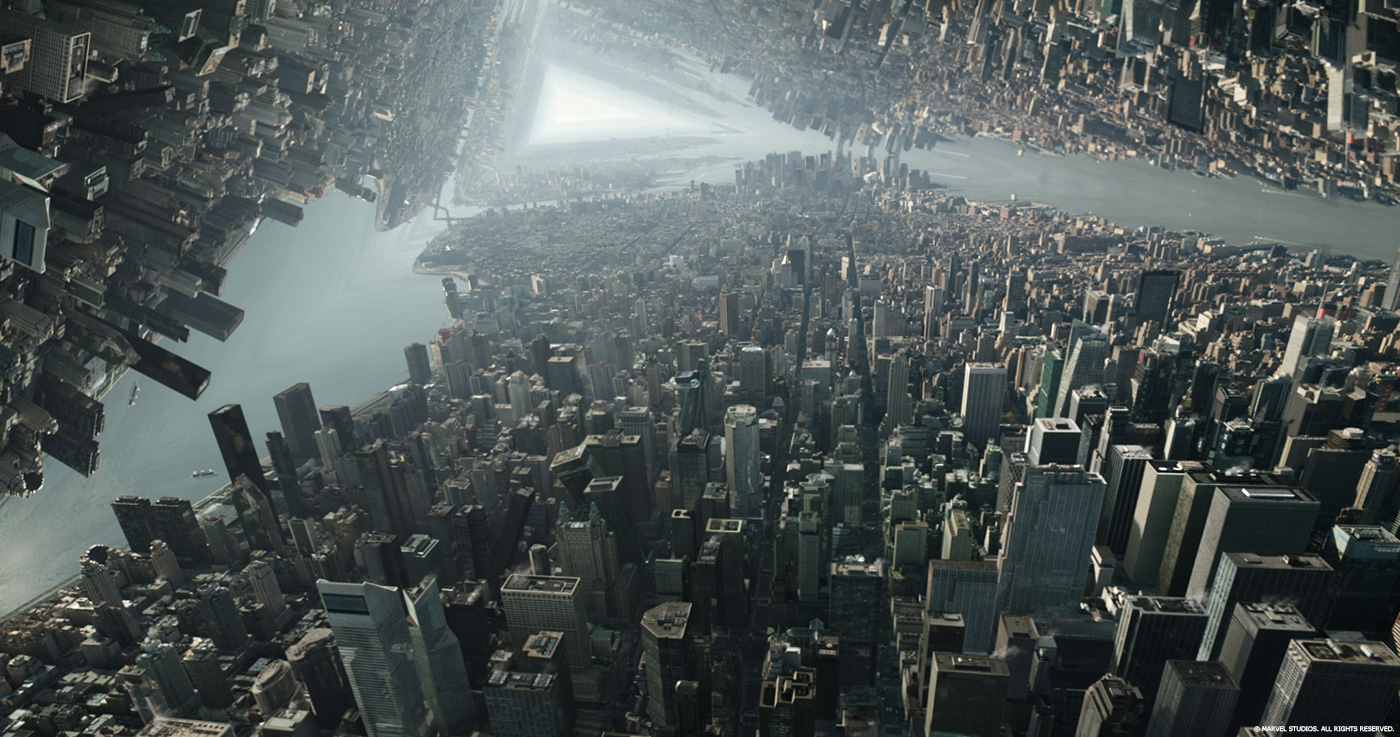In 2014, Richard Bluff explained to us about the work of ILM on LUCY. He then worked on UNBROKEN, AGENT CARTER and THE BIG SHORT. He’s now back in the Marvel universe with DOCTOR STRANGE.
How did you get involved on this show?
I was brought in to a brain storming session at ILM in October of 2014 along with a number of other Supervisors in order to discuss early art work from Marvel. A few weeks later while involved with an initial bid for the show Stephane Ceretti Marvel’s VFX Supervisor and Susan Pickett the overall VFX Producer on the show, reached out to me to discuss how I had approached sequencing the trippy one-off effects on Luc Besson’s LUCY and the potential of New York shoot. I already had a past relationship with Susan from working on the first THE AVENGERS film fulfilling the role of ILM Environment Supervisor for the fully digital New York sequence. Within a few months I was installed as the VFX Supervisor on behalf of ILM and we started DOCTOR STRANGE development work.
What was your feeling to be back in the Marvel universe?
I was thrilled to be working with Marvel again. I’ve always really enjoyed working on their projects, whether it was as an artist on the first two IRON MAN movies, a department supervisor on THE AVENGERS or as a VFX Supervisor on AGENT CARTER and DOCTOR STRANGE. They deserve great credit for how they work. They care deeply about every aspect of what they’re producing, they work tirelessly to produce them and the results are hugely successful. DOCTOR STRANGE for me was fun from the beginning right until the very end for many reasons it was a very unique project.
What are the sequences made by ILM?
ILM executed the VFX for the New York Mirror Dimension sequence, the time reversal Hong Kong sequence and the first reveal of the New York Sanctum exterior.
In pre-production we developed the Eldritch Magic whip weapon and worked extensively on the Astral Projection effect before that was passed off to other vendors at which point the direction changed as the film-makers honed in on their look.
In the movie, the characters can reshape the world around them. How did you approach this effect?
During production we regularly gathered in my office, conferencing in our team in Vancouver as we studied the previz, reference material and our in progress shots together. We talked at length about what we could do to realize the filmmakers vision, and how far we could take the design language. The meetings were very free-form and crazy ideas were encouraged, although you’ll be surprised how often you’d have to tell people they have the freedom to produce bonkers first knowing we can always tone it down later.
We even joked that perhaps the only enteritis that could see the mirror dimension were the main characters and pigeons because whenever we added photographed elements of them perched on a wall the timing of them flying off always coincided with the world starting to rotate or kaleidoscope – in the end we decided to not think about that too much and enjoy an accidental in-joke. We have a lot of incredibly talented artists who jumped at the chance to break the rules and more often than not they’d show up the next day with a test of something they’d been thinking about.
The challenge for me and the shows overall Compositing Supervisor Jason Porter, was to make sure what we were creating remained faithful to the previz and story. For example, it was important to ensure that when the shot was about the characters in jeopardy that the movement and appearance of the environment remained in the background and didn’t draw too much attention, whereas when the characters were small during a wide shot that the environment became the character and the point of interest.
Whenever we presented to the film-makers we almost always showed three versions of every shot. I would introduce the first version as vanilla, the second as chocolate and the third and craziest of all as something like ‘caramel explosion strawberry cheesecake with a cherry’. They always went for crazy.
Can you explain in details about the creation of the New York folding and splitting effect?
We tried to come up with ideas to dissect the geometry in the scenes in order to rebuild it in infinitely more complex ways. We used fractal geometry, iterated function systems and kaleidoscopic ideas to generate complexity from simple functions. In some cases we simply tried to find moments in fractal geometry which matched our buildings combining it together and make it more complex.
Procedural tools were a key part of folding and warping New York City, with the vast complexity of buildings, streets, traffic, and people. Under the Supervision of Adam Watkins and Martijn Van Herk one such tool that was developed which was pivotal to the sequence was the city block Kaleidoscope plugin that worked like a child’s Kaleidoscope toy.
We begin with a New York City block that was fully realized in 3D, we then introduced a series of « virtual mirrors » that sliced through the buildings at any angle. Each slice added made a 3D mirrored version of the buildings which is added to the mirrored state of all slices that came before it. After just a few slices, a city block can be changed into a vastly surreal version of itself. As a final touch, we would add rotation to those slices, resulting in a 3D Kaleidoscope effect that is absolutely mesmerizing to watch.
The characters are using magic. Can you explain in details about its creation?
The various Eldritch Magic weapons worked in very similar ways. The Ancient One’s Fandala’s as an example were driven by base curves tracked to the plate character with art directed additional hand animation. The FX artists under the supervision of Georg Kaltenbrunner introduced extra levels of detail via textural noises and geometrical duplication and deformation techniques. Additionally they created procedural solar flare passes to further increase the complexity of the effect. Various particle simulations were created based on performance cues and collision events, to create the signature heavy drip as well as the floating ember look. All of these elements we’re then layered together in Nuke by the compositors under the supervision of Matt Lane.
Can you tell us more about the Hong Kong sequence?
The Hong Kong time reversal sequence was executed almost entirely at ILM London under the day-to-day supervision of Mark Bakowski, CG Supervisor Daniele Bigi and Compositing Supervisor Marian Mavrovic.
One of the challenges early on was how to breakdown what was required for each shot. Consider a shot where you have principal actors performing forward colliding with background actors performing backwards, secondary passes with the camera travelling backwards shooting extras performing forwards at multiple frame rates layered over backwards destruction times 150+ shots.
The reverse destruction was overseen by George Nakhle and Peter Kyme with the work executed in Houdini and rendered through Katana with RIS. The destruction was simulated forwards with the intention of being viewed backwards, although forwards motion was reviewed for sanity checking the physics, backwards was the primary consideration. The first simulation of any shot was only ever a starting point as it would go through many refinement passes as the FX artists hand crafted the motion, timing and composition to ensure we made the most of every collapse.
We were guided by the film-makers to ensure we kept an even flow throughout the sequence and were reminded about playing to the strengths of the reversing sound effects. It was especially important during the close up moments to continue to remind the viewers that time was reversing and we achieved that by crafting self-contained destruction beats which had a begging, middle and end in the same shot rather than a wall of continually raining debris.
How did you create the Dark Dimension over Hong Kong?
The majority of the credit goes to Miguel Santana at ILM London and the work he did to drive the look forward with environment and FX artists. We partnered with Luma Pictures, who were designing and executing the Dark Dimension for the climactic sequence in the movie, for the Dark Dimension renders. After providing them our shot cameras they generated a variety of layers we could use to create and compose elements in our shots. Miguel sliced and diced the components working up a composition that felt present within the city but also providing depth to suggest you were looking through a window to another world. On top of the Dark Dimension Miguel layered numerous effects and treatments including a distortion effect which ate away the buildings triggering flying particles suggesting the buildings being consumed.
What do you keep from this experience?
I really enjoy projects that on the first viewing of the previz you’re amazed but at the same time you have that cold sweat moment as you think ‘that’s amazing how the hell are we going to do this”. DOCTOR STRANGE was exactly that kind of project and it fed in to exactly the kind of show I like to run where every artist is challenged and fully engaged in the creative process with the film-makers. Individuals made significant design contributions to the movie and helping them to achieve that successfully gave me the most satisfaction.
How long have you worked on this film?
20 months.
How many shots have you done and what was the size of your team?
Between London, Vancouver and San Francisco a team of approximately 100 people contributed 288 shots
What is your next project?
Various projects happening in a Galaxy Far, Far Away…
A big thanks for your time.
// WANT TO KNOW MORE?
– Industrial Light & Magic: Dedicated page about DOCTOR STRANGE on ILM website.
© Vincent Frei – The Art of VFX – 2016










